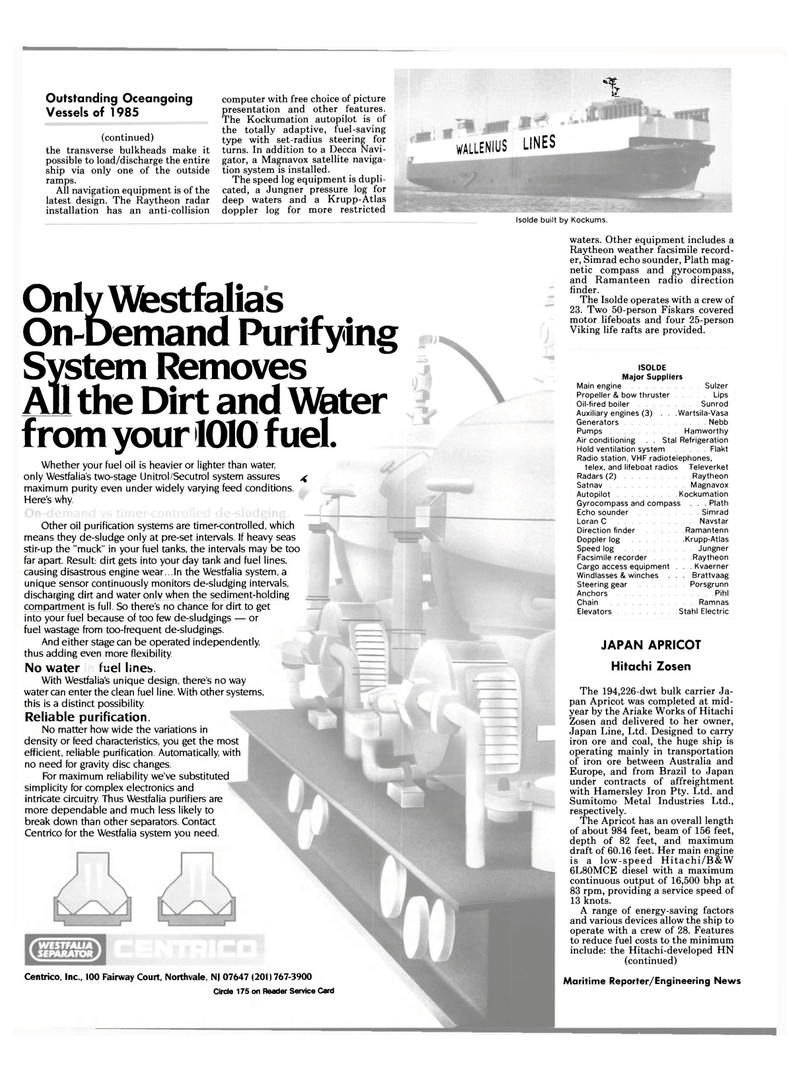
Page 30: of Maritime Reporter Magazine (December 1985)
Read this page in Pdf, Flash or Html5 edition of December 1985 Maritime Reporter Magazine
Outstanding Oceangoing
Vessels of 1985 (continued) the transverse bulkheads make it possible to load/discharge the entire ship via only one of the outside ramps.
All navigation equipment is of the latest design. The Raytheon radar installation has an anti-collision computer with free choice of picture presentation and other features.
The Kockumation autopilot is of the totally adaptive, fuel-saving type with set-radius steering for turns. In addition to a Decca Navi- gator, a Magnavox satellite naviga- tion system is installed.
The speed log equipment is dupli- cated, a Jungner pressure log for deep waters and a Krupp-Atlas doppler log for more restricted
WALLENIUS LINES %
Isolde built by Kockums.
Centrico, Inc., 100 Fairway Court, Northvale, N) 07647 (201)767-3900
Circle 175 on Reader Service Card
OnlyWestfalias On-Demand Purifying
System Removes M the Dirt and Water from your 1010 fuel.
Whether your fuel oil is heavier or lighter than water, only Westfalia's two-stage Unitrol/Secutrol system assures 4 maximum purity even under widely varying feed conditions.
Here's why.
Other oil purification systems are timer-controlled, which means they de-sludge only at pre-set intervals. If heavy seas stir-up the "muck" in your fuel tanks, the intervals may be too far apart. Result: dirt gets into your day tank and fuel lines, causing disastrous engine wear...In the Westfalia system, a unique sensor continuously monitors de-sludging intervals, discharging dirt and water only when the sediment-holding compartment is full. So there's no chance for dirt to get into your fuel because of too few de-sludgings — or fuel wastage from too-frequent de-sludgings.
And either stage can be operated independently, thus adding even more flexibility.
No water in fuel lines.
With Westfalia's unique design, there's no way water can enter the clean fuel line. With other systems, this is a distinct possibility.
Reliable purification.
No matter how wide the variations in density or feed characteristics, you get the most efficient, reliable purification. Automatically, with no need for gravity disc changes.
For maximum reliability we've substituted simplicity for complex electronics and intricate circuitry. Thus Westfalia purifiers are more dependable and much less likely to break down than other separators. Contact
Centrico for the Westfalia system you need. waters. Other equipment includes a
Raytheon weather facsimile record- er, Simrad echo sounder, Plath mag- netic compass and gyrocompass, and Ramanteen radio direction finder.
The Isolde operates with a crew of 23. Two 50-person Fiskars covered motor lifeboats and four 25-person
Viking life rafts are provided.
ISOLDE
Major Suppliers
Main engine Sulzer
Propeller & bow thruster Lips
Oil-fired boiler Sunrod
Auxiliary engines (3) . . .Wartsila-Vasa
Generators Nebb
Pumps Hamworthy
Air conditioning . . Stal Refrigeration
Hold ventilation system Flakt
Radio station, VHF radiotelephones, telex, and lifeboat radios Televerket
Radars (2) Raytheon
Satnav Magnavox
Autopilot Kockumation
Gyrocompass and compass . . . Plath
Echo sounder Simrad
Loran C Navstar
Directionfinder Ramantenn
Doppler log Krupp-Atlas
Speed log Jungner
Facsimile recorder Raytheon
Cargo access equipment . . . Kvaerner
Windlasses & winches . . . Brattvaag
Steering gear Porsgrunn
Anchors Pihl
Chain Ramnas
Elevators Stahl Electric
JAPAN APRICOT
Hitachi Zosen
The 194,226-dwt bulk carrier Ja- pan Apricot was completed at mid- year by the Ariake Works of Hitachi
Zosen and delivered to her owner,
Japan Line, Ltd. Designed to carry iron ore and coal, the huge ship is operating mainly in transportation of iron ore between Australia and
Europe, and from Brazil to Japan under contracts of affreightment with Hamersley Iron Pty. Ltd. and
Sumitomo Metal Industries Ltd., respectively.
The Apricot has an overall length of about 984 feet, beam of 156 feet, depth of 82 feet, and maximum draft of 60.16 feet. Her main engine is a low-speed Hitachi/B&W 6L80MCE diesel with a maximum continuous output of 16,500 bhp at 83 rpm, providing a service speed of 13 knots.
A range of energy-saving factors and various devices allow the ship to operate with a crew of 28. Features to reduce fuel costs to the minimum include: the Hitachi-developed HN (continued)
Maritime Reporter/Engineering News

 29
29

 31
31
